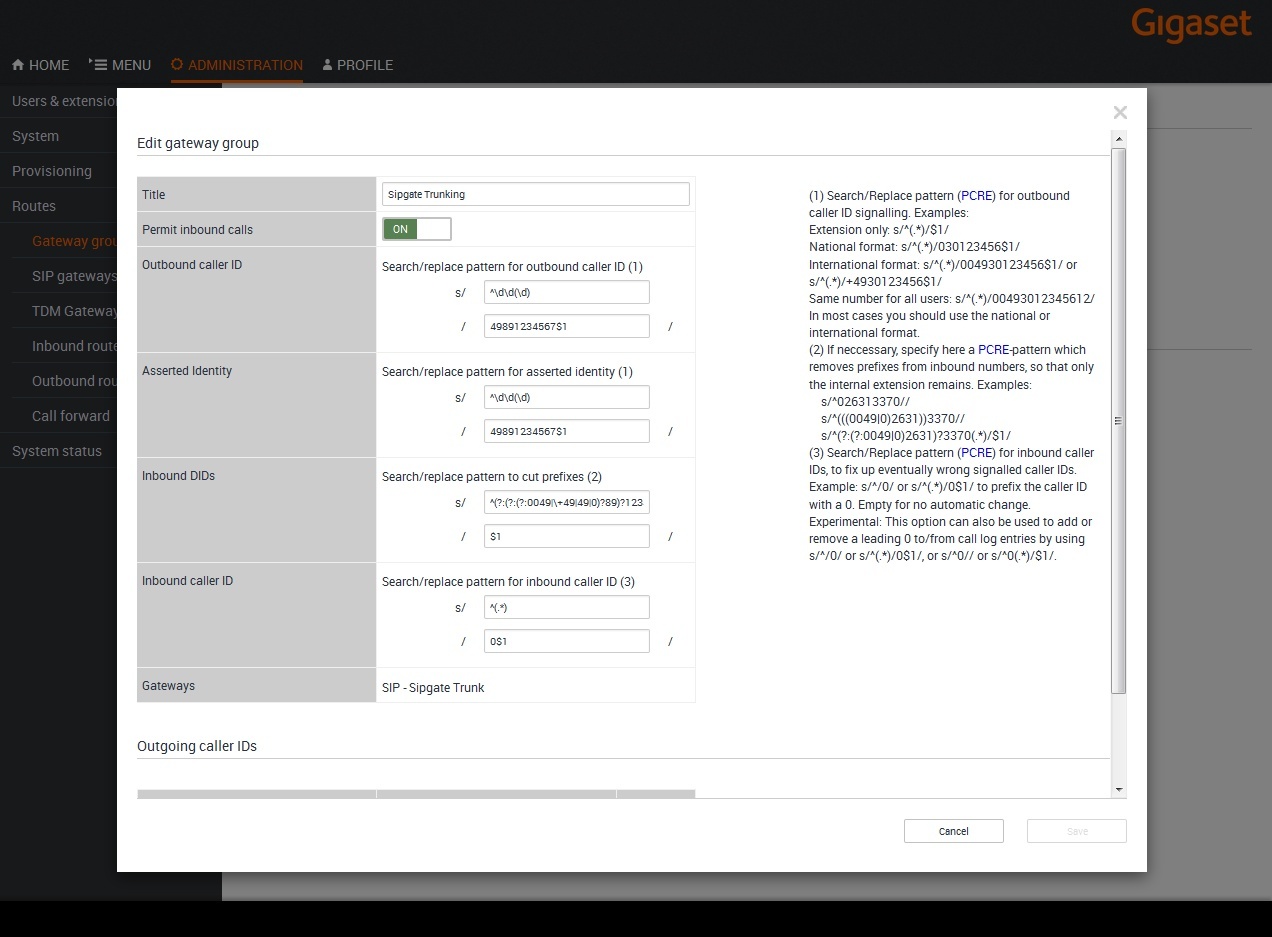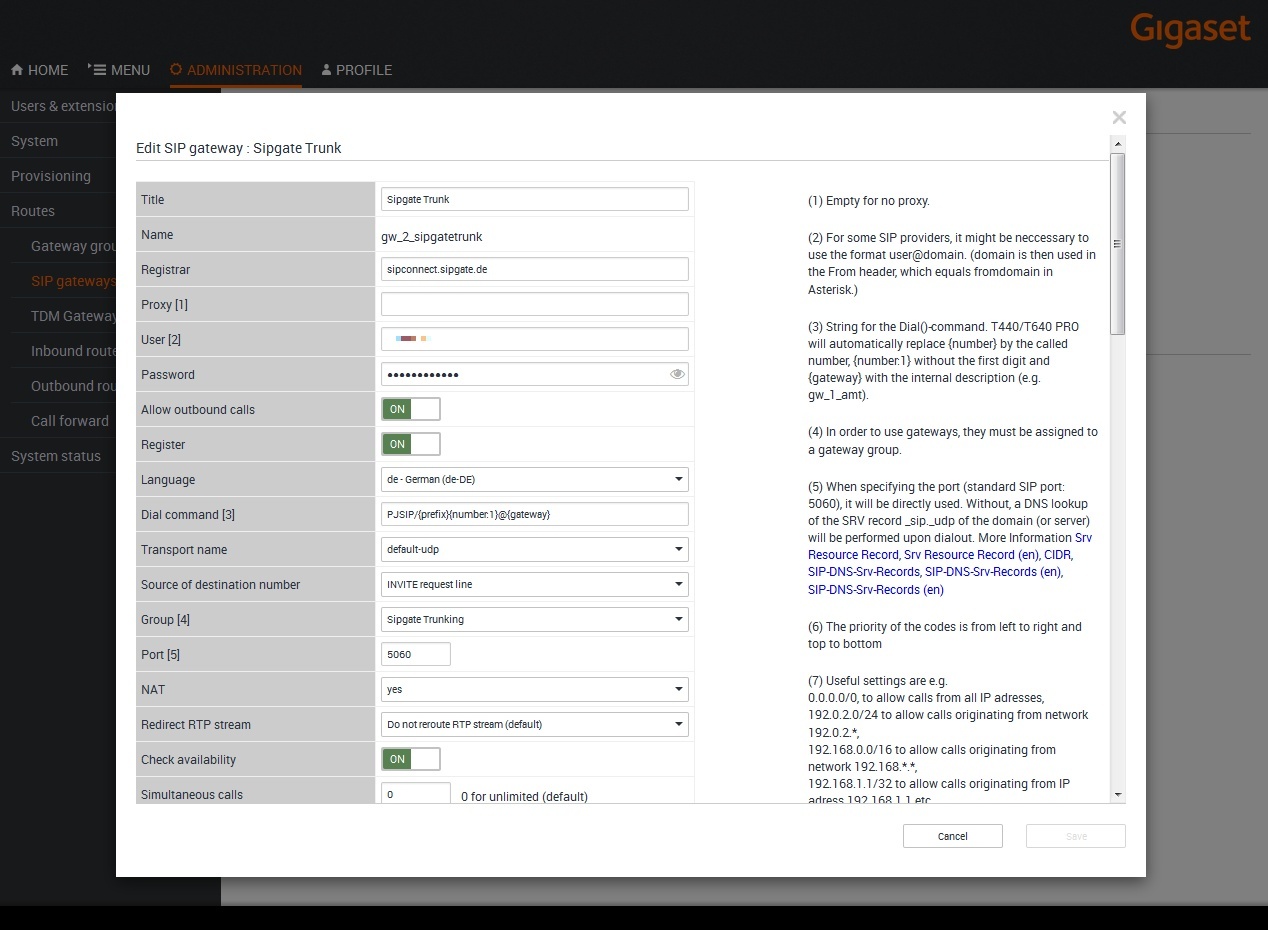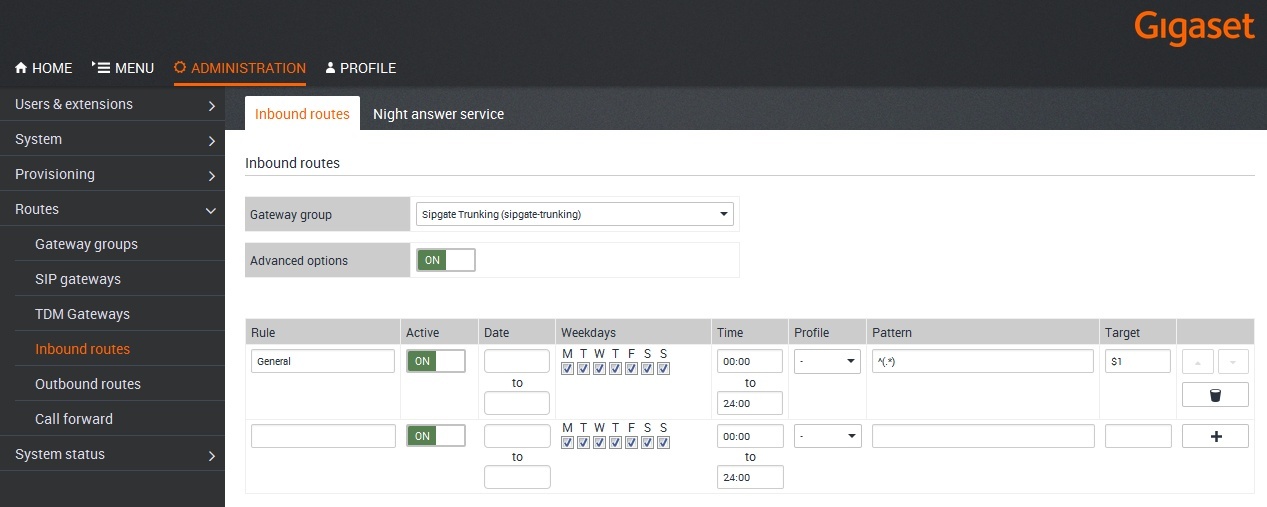Sipgate trunking
| Feature | |
|---|
| Outgoing Calls | Yes | | Incoming Calls | Yes | | CLIP incoming | Yes | | CLIP outgoing | Yes | | Call Forwarding | Yes | | Call Transfer | Yes | | Call Waiting | Yes | | DTMF | Yes | | Anonymous Call | Yes | | A-number forwarding | No | | Fax | see chart below* |
*= Sipgate Trunking offers a full Fax2Mail solution via their web-platform. Preferably use this service! |
|
Gigaset T440/T640 PRO settings.
For entering a new SIP trunk into the PBX, you need some steps:
- Adding a new Gateway group
- Adding a new SIP gateway
- Defining the inbound routes (assignment of number to extension)
- Defining the outbound routes
Let's assume our SIP trunk contains the following numbers:
0891234567[0-9]
And we choose follwowing internal numberblock:
67[0-9]
And we have a '0' as line-prefix.
Gateway Group
In the Gigaset PBX go to "Administration" - "Routes" - "Gateway groups" enter a name for the new group and click on: Create new group
In the Gateway group you have to define the Outbound Caller ID, the Asserted Identity settings, the Inbound DIDs (how the number is forwarded to the Inbound routes) and the Inbound caller ID (number presentation of external caller). in addition you can permit here inbound calls in general for this gateway group.
 Example of Sipgate trunking gateway group settings. |
Outbound caller ID As just the last digit of the trunk number block is changing, you can select just the last digit (in brackets, here: ^\d\d(\d)) and put it into the variable $1. As the provider wants the signalling number in the format (country-code)(city-code)(number), you have to enter this number into the next line (here: 49891234567$1, where the $1 represents the changing part). The provider will take care about the number representation to the called party. He will present e.g. 08912345678 to the calling party. In case your block contains more numbers, you can change the first expression to ^\d(\d\d) or even ^(\d\d\d). Then you have to check if also the second expression has to be changed, e.g. from 49891234567$1 to 4989123456$1. Asserted Identity These fields are used specially for external forwardings. Some providers need special settings in order to present the correct number at the receiving party. For Sipgate trunking accounts these settings need the same values than the Outbound caller ID. Here: ^\d\d(\d) and 49891234567$1
Inbound DIDs For incoming calls, you can use the regular expression, generated by the setup assistant. In your case you would have to adjust the city-code and the first part of the extension, according to your line-settings. Here: ^(?:(?:(?:0049|\+49|49|0)?89)?12345)?(.*)
This expression cuts all possibly available country- and city-codes and the pilot-number from the incoming number and only the extension is remaining (here: 678). This will be forwarded to the Inbound Routes. Inbound caller ID For incoming calls, we will add an additional 0 in front of the external number of the caller, in order to use the callback-feature of the phone (e.g. 0089987654321). During the call-setup the additional 0 will be automatically removed. Gateways This field will be empty when you create this Gateway group. It will show later the assigned SIP gateways. |
|
SIP gateway
In the Gigaset PBX go to "Administration" - "Routes" - "SIP gateways" enter a name for the new gateway and click on: Create new gateway
The SIP gateway contains all necessary data for the registration and dial command and how the number is delivered to/from the provider.
Just enter or choose the values according to your contract or data you received from the provider.
 Example of Sipgate trunking gateway settings 1/2.  Example of Sipgate trunking gateway settings 2/2. |
Dial command The dial command is the command which is used in the asterisk software. The term {number:1} means, that at the dialled number (e.g. 008987654321) the first digit is removed. If you don't use a line access code (in most cases '0' is used), you have to remove the ':1' ! ! ! In case you want to use the prefix in the outbound routes, you have to enter '{prefix} to the dial command: SIP/{prefix}{number:1}@{gateway} Group Select here the previously created gateway group. Update remote party ID / P-Asserted-Identity (CLIP) These settings are just optional, as the provider replaces outgoing CLIP which is not valid with the default number of the SIP account. T.38 support In order to have the best fax support on the FXS ports, you have to deactivate the T.38 support option. A fallback to G.711 will be used instead.
Advanced Parameter You have to enter the complete term username=12345678t9 in the value-field and press the plus-sign. Underneath you will see then a preview of the entry in the sip.conf file. |
|
Inbound routes
In the Gigaset PBX go to "Administration" - "Routes" - "Inbound routes" select the correct Gateway group and press Show.
In addition it is advised to activate the advanced options by clicking it to 'ON' and then pressing Show.
 Example of Sipgate trunking Inbound routes. |
Rule Enter here a name for the according rule. Date / Weekdays / Time With these settings you can configure a time-controlled routing to different targets. Pattern / Target In the pattern you define which part of the incoming number is used to forward the call to the according extension. Because we already receive the correct extension from the gateway group, we don't need any further number manipulation here. In our example we forward incoming calls directly to the according extension. The shown example is the easiest way for a block of numbers, but also other configurations or assignments are possible.
|
|
Outbound routes
In the Gigaset PBX go to "Administration" - "Routes" - "Outbound routes" activate the Advanced options by clicking it to 'ON' and then pressing Show.

Example of Sipgate trunking Outbound routes. |
Rule Enter here a name for the according rule. Date / Weekdays / Time With these settings you can configure a time-controlled routing. Pattern
In the pattern you define how the outside line is seized. In our example all dialled numbers starting with '0' will use the Gateway group Sipgate trunking. |
|
Fax support
Fax has been tested (11.08.2016). These results are without a guarantee. Due to different end-devices, configuration of PBX or other settings the fax transmission might fail.
| | Sending |
|---|
Receiving |
|---|
| Internal FXS | Internal T38-Fax | External T38-Fax | External machine-Fax |
| Internal FXS | --- | --- | Yes* | Yes* |
| Internal T38-Fax | --- | --- | No | No |
| External T38-Fax | Yes* | No | --- | --- |
| External machine-Fax | Yes* | No | --- | --- |
Used devices or services:
Canon Fax-L100 (internal FXS), www.minifax.de (external T38-Fax), Triumph Adler DCC 2725 (external machine-Fax)
* = T38 option in SIP gateway deactivated